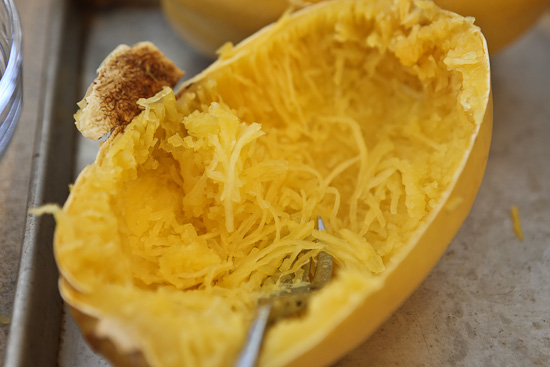If you’re like us, you love pasta. Also, if you’re like us, you may be getting a little bit worried that your midsection is starting to look a little like twirled spaghetti on a fork. You keep twirling, it keeps growing. As delicious as it may be, pasta is still a heavy carb – more than a few spaghetti and meatball nights in a row and you’ll start to wonder how Super Mario ever managed to squeeze through a pipe.
There are a number of interesting solutions to the pasta problem. The most obvious one is to limit your intake of delicious noodles, but who wants to do that? Then there are the various whole grain, multi grain, no grain, what-have-you pastas. They’re certainly interesting, and worth a try, but on the whole they aren’t terribly better for you than the real deal.
Then there is the Spaghetti Squash. It’s a vegetable, so we can probably surmise that it’s at least a little bit healthier than what is essentially boiled bread. It’s also bright yellow. We’re very strong exponents of bright yellow foods, here at The Culinary Exchange. Not because we’re proponents of weird color-coded fad diets, but because bright yellow foods always look so cheerful in the kitchen. Plus the orange ones are very high in vitamins A and beta carotene!
How To Cook Spaghetti Squash
So how do you cook this bright yellow pastarific squash? It turns out it’s easier than you think. The simplest method is to roast it. Spaghetti squash is a winter squash (no, it doesn’t grow in the winter – it’s called winter squash because it is harvested late, once it has fully matured, and is capable of being stored for use in winter). That means two things – first, it has a very tough skin, and second, it takes a while to get ready.
How To Roast Spaghetti Squash
Start by cutting it in half. Remember that tough skin? You might want to consider using a bread knife or other serrated blade. Ok, got two halves of squash? Perfect! Remove the seeds and stick them face down in a baking dish with a little bit of oil and water in it, cover the whole thing with foil to seal in the steam (it keeps the squash nice and tender while it roasts), and stick the whole thing in the oven at 350 degrees Fahrenheit for about an hour. Once it’s cooked, use a fork and spoon to pull out delicious angel-hair-like strands of squash, plate, and cover in a sauce of your choice!
How To Microwave Spaghetti Squash
Did I say roasting spaghetti squash was the simplest method? Well, I may have bent the truth a little. In fact, the simplest method is to microwave it! What won’t science come up with next. This process is even simpler than roasting. Cut the squash in two, brush on some olive oil, place in a covered microwave-safe dish, and nuke for about 7 minutes. Pull it out (very carefully, it will be very hot), rotate and flip it, and stick it back in for another 7 minutes. If it’s still not soft to the touch, let it rest a minute or two and then put it back in (flipped and rotated) for another 3-5 minutes. Pull it out, let it sit, and then use a fork to spaghetti-fy it.
How To Serve Spaghetti Squash
Now that you have a big, heaping bowl of spaghetti squash, what do you do with it? Why, serve it the way you would any thin-stranded pasta dish. With a couple of caveats, of course. The strands of spaghetti squash are a lot more delicate than pasta, so be careful of mixing it too much, lest you end up with a bunch of teeny tiny pieces of “pasta” that are impossible to roll on a fork. They also are not as flavorful as pasta, or even other squash. This can be a good thing – really delicate sauces that might be overwhelmed by pasta can come alive on spaghetti squash; really robust sauces, like curries and italian sausage meat sauce, come through really strong with no interference.
If you’re feeling REALLY adventurous, you might try a dessert spaghetti sauce pasta – use some cream, some marscapone, and some fruit (orange is a favorite) to whip up a delectable sweet finish without the guilt that a bowl of linguine always brings to the table.
Bon Appetite!





